Click on images to enlarge
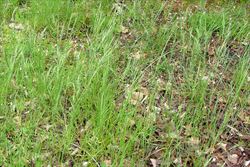
infestation (Photo: Sheldon Navie)
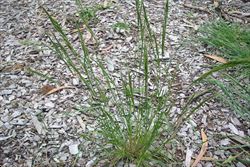
habit (Photo: Sheldon Navie)
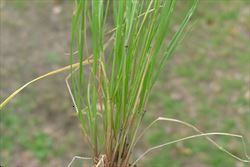
slender stems and leaves (Photo: Sheldon Navie)
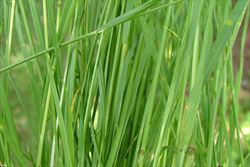
close-up of stems and leaves (Photo: Sheldon Navie)
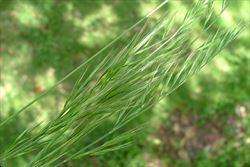
seed-heads borne well above the leaves (Photo: Sheldon Navie)
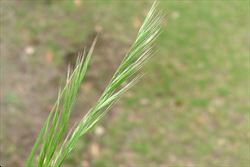
immature seed-heads, showing their one-sided nature (Photo: Sheldon Navie)
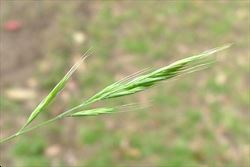
close-up of immature flower spikelets, each with several slender awns (Photo: Sheldon Navie)
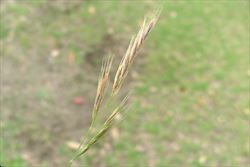
mature seed-head (Photo: Sheldon Navie)
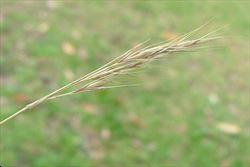
close-up of mature flower spikelets (Photo: Sheldon Navie)
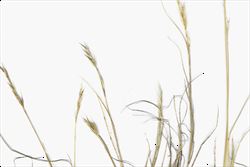
old seed-heads (Photo: Forest and Kim Starr, USGS)
Scientific Name
Vulpia bromoides (L.) Gray
Synonyms
Festuca bromoides L.
Family
Gramineae (South Australia)Poaceae (Queensland, New South Wales, the ACT, Victoria, Tasmania, Western Australia and the Northern Territory)
Common Names
barren fescue, brome fescue, brome six-weeks grass, desert fescue, European foxtail fescue, fall panic grass, fescue grass, hair grass, silk grass, silver grass, silver-grass, silvergrass, six weeks fescue, six-weeks fescue, squirrel tail, squirrel tail fescue, squirrel's tail fescue, squirrel-tail fescue, squirreltail fescue, squirrel-tailed fescue, vulpia, vulpia hairgrass
Origin
Native to eastern Africa, the Azores, the Madeira Islands, the Canary Islands, Europe, the middle-east and western Asia.
Naturalised Distribution
Widely naturalised in southern Australia (i.e. in New South Wales, the ACT, Victoria, Tasmania, many parts of South Australia and large parts of south-western and western Western Australia). Also occasionally naturalised in south-eastern Queensland and on some offshore islands (i.e. Lord Howe Island and Norfolk Island).
Widely naturalised in other parts of the world, including in southern Africa, the Mascarenes, New Zealand, Hawaii, North America (the USA and Canada) and the Caribbean.
Habitat
A serious weed of crops, pastures, roadsides, lawns, footpaths, coastal environs, grasslands, open woodlands, disturbed sites and waste areas in temperate, semi-arid and sub-tropical regions.
Habit
A short-lived (i.e. annual) loosely tufted grass usually growing 5-40 cm tall, but occasionally reaching up to 60 cm in height.
Distinguishing Features
- a short-lived loosely tufted grass usually growing 5-40 cm tall, but occasionally reaching up to 60 cm in height.
- its long and narrow leaf blades (1-18 cm long and 0.5-3 mm wide) are hairless or sparsely hairy.
- its elongated seed-heads (2-12 cm long and 4-13 mm wide) are made up of several short branches that are closely held to the stem.
- these seed-heads are predominantly one-sided in nature, and have numerous elongated flowers spikelets (6-14 mm long and about 4 mm wide).
- the 'seeds' (3.5-4 mm long) are topped with an awn 4-15 mm long.
Stems and Leaves
The mostly upright flowering stems (i.e. erect or geniculate culms) are slender and hairless (i.e. glabrous).
The leaves consist of a leaf sheath at the base, which partially encloses the stem, and a spreading leaf blade. Their sheaths are hairless (i.e. glabrous) or sparsely hairy (i.e. pilose) and their blades are flat or slightly inrolled (i.e. involute). The long and narrow (i.e. linear or filiform) leaf blades (1-18 cm long and 0.5-3 mm wide) have entire margins and pointed tips (i.e. attenuate apices). They are hairless (i.e. glabrous) or sparsely hairy (i.e. pubescent) on their undersides. Where the leaf sheath meets the leaf blade there is a tiny membranous structure (i.e. membranous ligule) 0.2-0.6 mm long.
Flowers and Fruit
The elongated seed-heads (2-12 cm long and 4-13 mm wide) are made up of several short branches that are closely held to the stem (i.e. contracted panicles), though the lowermost branches may sometimes be slightly spreading. These seed-heads are upright or nodding, predominantly one-sided in nature, and consist of numerous elongated flowers spikelets. The individual flower spikelets (6-14 mm long and about 4 mm wide) are borne singly on short stalks (i.e. pedicels) 1-6 mm long. They consist of a pair of bracts (i.e. glumes), one of which is somewhat larger than the other (lower 2-6 mm long and upper 4.5-10 mm long), and 3-10 tiny flowers (i.e. florets). Each of these florets has a pair of floral bracts (i.e. lemma and palea), the lower of which is topped with an awn 4-15 mm long. They also have a single stamen and an ovary topped with a feathery stigma. Flowering occurs mostly during spring.
The flower spikelets break up at maturity, with each floret separating individually and the glumes remaining on the seed-head branches (i.e. they are persistent). The 'seed' (i.e. caryopsis or grain) is hairless (i.e. glabrous), 3.5-4 mm long, and remains hidden within the floral bracts.
Reproduction and Dispersal
This species reproduces only by seed, which may be dispersed shorter distances by wind or water. They readily become attached to animals, clothing and vehicles, and are also spread longer distances in contaminated agricultural produce.
Environmental Impact
Squirrel-tail fescue (Vulpia bromoides) is regarded as an environmental weed in Victoria and Western Australia.
Legislation
Not declared or considered noxious by any state government authorities.
Similar Species
There are several silvergrasses (Vulpia spp.) that can be easily confused with squirrel-tail fescue (Vulpia bromoides). These species are very difficult to tell from each other and a specialist text should be consulted for their identification (e.g. Ausgrass: an interactive key to Australian grasses).

